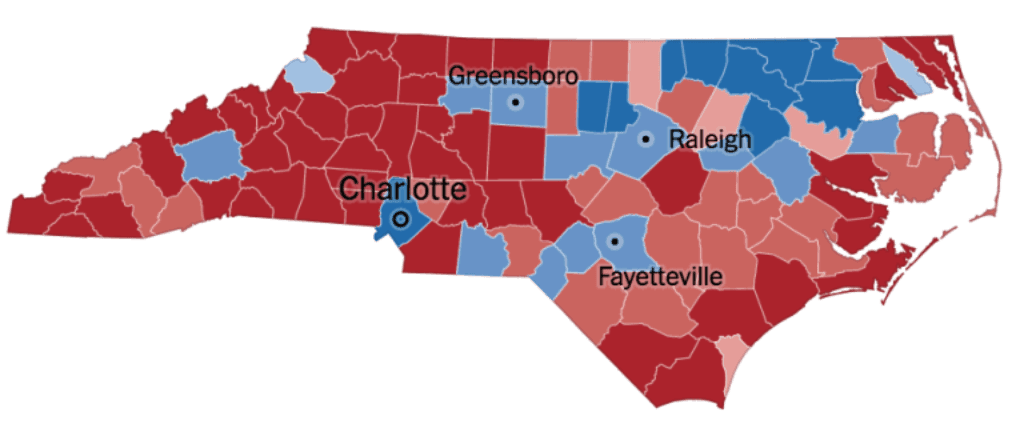
Below is a map of how counties voted in the past presidential election.

Lots of red in rural areas. Blue in metropolitan places and where the most attended colleges and universities are located. Those blue counties in the northeast are mostly African-American in population.
Mix these colors up as they are shaded and we get a fairly purple shade. But looking at the map broken down by the 100 counties in North Carolina, it is apparent that we as a state have a very deep and wide urban/rural divide.
North Carolina has 100 counties, each with a county public school system (and 15 other city school systems). According to the Labor and Economic Analysis Division of the N.C. Department of Commerce, the public schools are at least the second-largest employers in nearly 90 of them — and the largest employer, period, in over 60. That means educators, administrators, and support staffs represent a base for most communities.
Simply put, it means the public school system is as concrete a foundation in every county in North Carolina from the reddest rural municipalities to the bluest urban districts.
Every state budget makes public education its highest monetary commitment. It has to be that way; the state constitution that presides over us stipulates that.
Our state (like all the other states) attracts industry, talent, and other priceless investments because of the strength of our existing infrastructure. But that infrastructure is only as strong as the very aspects that help to keep the state connected. And in a time where we have growing political polarities not just between political parties but within political parties, we have a deep urban / rural divide.
Public education bridges that divide.
When we as a state fully invest in public education, we invest in our students, our growth, our future, our economy, and most importantly our common connections.
And public education is based on the human aspect. People. Investing in public education means investing in people and fully funding the very resources and development those people need to help the most important people: our students.
Whether one sends his/her children to private schools or home schools them, the state of the public education system still affects them greatly. Whether one has no children in school but owns a business and hires people, the state of the public education system still affects them greatly. Anybody who owns a home or real estate knows that the strength of the local school system has an effect on the value of their property.
In some direct or indirect way, the effect of a strong public education system can be seen and felt in so many facets of both rural and urban localities that to try and identify those effects would require its own dissertation – from a public university.
Yes, public education is a political issue, but it does not have to be a partisan one. It shouldn’t be partisan. Decades ago, public education was championed by both Democrats and Republicans alike. Think of governors like Holshousher and Martin and you will see a commitment to funding public education like N.C. saw with Sanford, Hunt, and Easley. The governor’s office and the General Assembly were often in different hands politically speaking, but on the issue of public education, they stood much more united than it is today.
They wanted to make sure there was a bridge over any urban/rural divide.
The surest way to help keep strong connections in our state is to make sure that those who are in power as politicians are pro-public education, not just with their words, but also with their actions.
Bridges are great constructs. No matter how deep the chasm or the divide. They help connect different sides.
Recommended reading



